March 10, 2017
Air Date: March 10, 2017
FULL SHOW
SEGMENTS
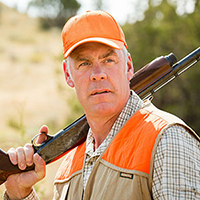
Ryan Zinke, Interior Secretary, Sportsman and Conservationist
View the page for this story
The new Interior Secretary, Ryan Zinke, is a keen outdoorsman who advocates multiple uses for federal public lands and keeping them in federal control, not the states. Dale Hall, CEO of Ducks Unlimited and former Director of the U.S. Fish and Wildlife Service, tells host Steve Curwood why his organization applauds Secretary Zinke’s appointment, and describes the challenges ahead for the former Navy Seal and former Congressman from Montana who’s now in charge of one in every five acres of US soil. (12:20)
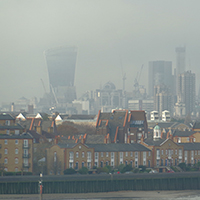
Smog-Shrouded London
View the page for this story
Decades ago, London suffocated under poisonous smogs –and now deadly air is back. Diesel burning vehicles are causing record levels of pollution linked to thousands of deaths in the UK. The British government could face fines from the European Court of Justice if the smog is not controlled. Host Steve Curwood and James Thornton, CEO of ClientEarth, a public interest environmental law organization, discuss the fight over air pollution and what comes next. (09:40)
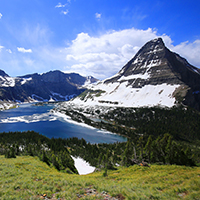
Dangerous Drifting Particles
View the page for this story
Polycyclic aromatic hydrocarbons are toxic air pollutants produced by combustion linked to lung cancer and other serious health problems. They’re mostly seen as a local bad air issue, but recent findings suggest that these tiny particles travel long distances and significantly increase overall health risks. Research co-author and Oregon State Chemistry Professor Staci Simonich, explains her findings to host Steve Curwood. (07:35)
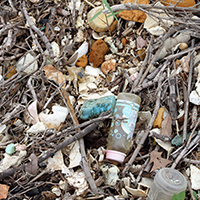
Beyond The Headlines
/ Peter DykstraView the page for this story
This week, Peter Dykstra and Host Steve Curwood assess the risks from potential Trump-approved EPA budget cuts and share new information tying the suspects of the 2016 murder of Honduran activist Berta Cáceres to US military training. Then, the two remember how conservation legislation brought the American Alligator back from the brink. (04:15)
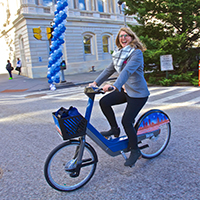
Women and Bicycling
/ Savannah ChristiansenView the page for this story
Women in the US face many hurdles when it comes to traveling around on two wheels. Living on Earth’s Savannah Christiansen reports on problems at the intersection of gender and bicycles, from personal safety concerns to the availability of bike paths separated from road traffic. (06:40)

Why I Wear Jordans in the Great Outdoors
View the page for this story
Though Bill McKibben wrote “The End of Nature” in 1989, several younger nature writers of the penned essays for the anthology “Coming of Age at the End Of Nature. But the millenial generation experiences a different nature from the pristine wilderness that inspired authors like John Muir. In an extract from his essay, environmental educator CJ Goulding explains how his Jordan sneakers help link youngsters of color to the great outdoors. (05:40)
Show Credits and Funders
Show Transcript
HOST: Steve Curwood
GUESTS: Dale Hall, James Thornton, Staci Simonich, CJ Goulding
REPORTERS: Peter Dykstra, Savannah Christiansen
[THEME]
CURWOOD: From Public Radio International, this is Living on Earth.
[THEME]
CURWOOD: I'm Steve Curwood. It was a showstopper. Interior Secretary Ryan Zinke rode up to his new job on a horse, of course!
HALL: He believes himself to be a Theodore Roosevelt conservationist. Theodore Roosevelt supported creating national forests and national parks, and the National Wildlife Refuge System began under him where people could get out and enjoy them and have consumptive uses as well.
CURWOOD: Also, how the image of bicycling the industry promotes has put women off the whole idea of getting on two wheels.
BALMER: Over the past 30 plus years, they’ve been selling the sport of cycling. If you say “cycling” to majority of people in the United States, especially women, that means MAMILs: Middle-Aged Men in Lycra [LAUGHS]. That’s not what most people want to see themselves riding.
CURWOOD: That and more, this week on Living on Earth. Stick around.
[NEWSBREAK MUSIC: Boards Of Canada “Zoetrope” from “In A Beautiful Place Out In The Country” (Warp Records 2000)]
[THEME]
Ryan Zinke, Interior Secretary, Sportsman and Conservationist
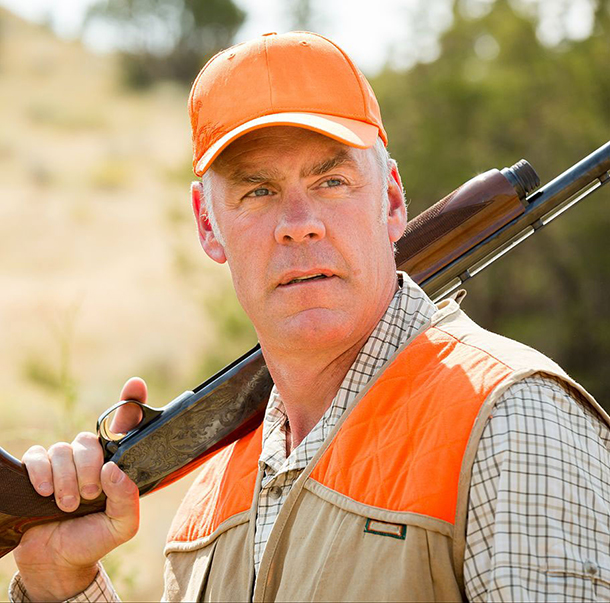
Secretary Ryan Zinke (Photo: U.S. Department of Interior, Wikimedia Commons public domain)
CURWOOD: From PRI, and the Jennifer and Ted Stanley Studios at the University of Massachusetts Boston, this is Living on Earth. I’m Steve Curwood.
When it comes to the federal government’s stewardship of the environment there is perhaps no more important official than the Secretary of the Interior, and our newest one is former Montana Republican congressman Ryan Zinke. The former Navy Seal is now in charge of managing around a fifth of the US land area, and a wide-ranging portfolio from national parks to Native American affairs. Dale Hall is the CEO of Ducks Unlimited and served under President George W. Bush as Director of the U.S. Fish and Wildlife Service, a branch of Interior. He joins me now to discuss Secretary Zinke’s appointment.
Dale, welcome to Living on Earth.
HALL: Well, thank you for having me.
CURWOOD: So, your organization Ducks Unlimited has applauded Ryan Zinke as the choice for Secretary of the Interior. Why?
HALL: Well, we think that Mr. Zinke understands the issues that the Department of the Interior will face. Many people don't realize that the Department of the Interior oversees one in every five acres of the United States, oversees all of the mineral and the energy extraction other than hydropower and nuclear energy. But the main reason is we believe that he understands our concerns and our, by that I mean the traditional hunting and fishing community that has really paid for the conservation in this country and has been there to try and help make sure the conservation is a generation to generation legacy. So, we really believe that his background growing up in Montana, living near national parks, living on the land, will help him be a good secretary.
Secretary Zinke rode to the Interior Department building on a horse his first day in office.
Honored to stand with the brave officers of @USParkPolice - these professionals put their lives on the line for us pic.twitter.com/QbtojcfvLV
— Secretary Ryan Zinke (@SecretaryZinke) March 2, 2017
CURWOOD: It made quite an impression on us when Secretary Zinke showed up to work on his first day on the back of a horse.
HALL: [LAUGHS] Yes, that was quite an entrance. We met with him that very morning. I was one of the people that met in his office, and I think he wanted to send a message that he is tied to the land and that the people on the land and who use our public lands that belong to them, he wanted to send a message, I believe, that he's going to be a person to make sure that the public gets to use those lands.
CURWOOD: He signed a couple of orders on that very first day. Tell me about the significance of what he signed. Let's start with Order 3347. That regards wildlife habitat and access to public lands.
HALL: Well, that has several parts to it, and it re-authorizes a wildlife council that's an advisory council to the Secretary of the Interior and the Secretary of Agriculture, and it is allowing the public to have a voice and to give advice on what kinds of things are important - Access for hunting and fishing and camping and all the outdoor recreational activities -- And making sure that we have a seat at the table. That’s really important, and it also, again, sent a message that he wants the public lands to be open for use.
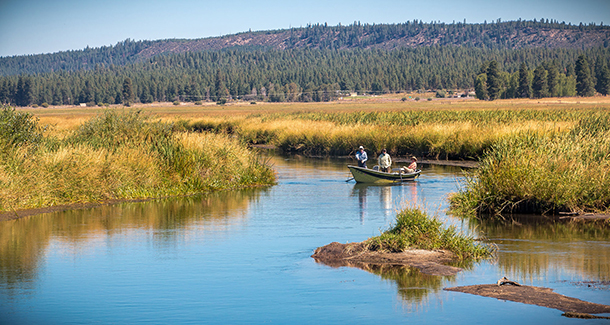
Secretary Ryan Zinke now oversees millions of acres where citizens get out on their public lands through hunting, fishing, hiking, and other outdoor recreation activities. (Photo: Bureau of Land Management Oregon and Washington, Flickr CC BY 2.0)
CURWOOD: Now, how do you anticipate Secretary Zinke will balance the various uses for federal public lands? I'm thinking of resource extraction, coal mining, oil and gas development, minerals extraction.
HALL: Well, in his comments, when we were together with him, he made it clear that he believes himself to be a Theodore Roosevelt conservationist. And if one looks at the history of Theodore Roosevelt, he supported creating national forests, national parks, and the National Wildlife Refuge System began under him where people could get out and enjoy them as well and have consumptive uses. So, in his words the other day, he said that while there are definitely places, and we need to protect those, where we go and take only photographs and leave only footprints, the vast majority of public lands are meant for the people to be able to have multiple uses on.
When you look at the mineral extraction that you mentioned, there are laws there that have to be followed, and if the public is entitled, after following all the rules associated with it, to able to make those extractions, then I believe the secretary will believe, the same way I do, that if the rules have been met then the law means for the people to be able to do those things.
On his first day in office, Secretary Zinke signed Orders 3346 and 3347.
Today I signed two secretarial orders to expand #hunting #fishing and #recreation on #publiclands. https://t.co/HhFBSIIETI pic.twitter.com/SddwIwzmUW
— Secretary Ryan Zinke (@SecretaryZinke) March 2, 2017
CURWOOD: And tell me about the other order that you were there to witness Secretary Zinke sign on day one. Now, this one overturns the US Fish and Wildlife Service ban on lead ammunition and fishing tackle, although of course the ban on lead shot remains in place for waterfowl hunting. Why?
HALL: Well, this whole “director’s order” was unfortunate. Having been the director of the Fish and Wildlife Service, the director has the ability to send out orders and then say, "All right, this is policy until it gets into the manual. Here's how we're going to run things that are under our responsibility." The unfortunate thing about this is, Ducks Unlimited, we're proud of the fact that we support science, and science means the scientific process, the scientific ethic. Let's vet the data that we have. Let's discuss the pros and cons, and then let's have a decision that is equal to, not greater than but equal to the science that is there, support it. This order did none of that. It was a last minute effort to try and put something out on the ground where there had been no scientific vetting. There have been no scientific discussion. So, we were really glad to see this withdrawn, and, if in the future the science does come out that justifies and supports that there should be additional bans on lead for hunting and fishing, then we're all for it. When the science was there to support a ban on lead for waterfowl hunting in 1992, we went to non-toxic shot and have been there ever since.
CURWOOD: To what extent do you think that this is an issue that is perhaps best left to the states?
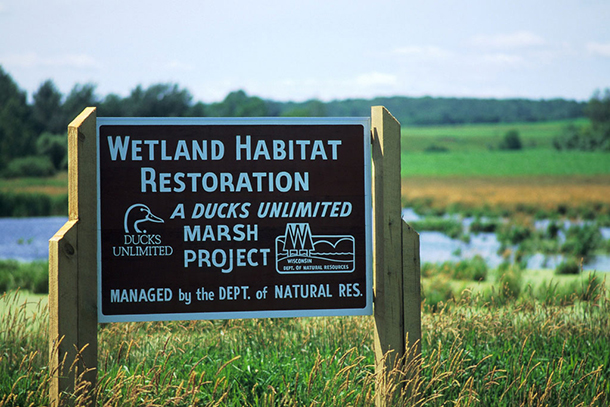
Ducks Unlimited has helped restore about 14 million acres of wetlands (Photo: Wisconsin Department of Natural Resources, Flickr CC BY-ND 2.0)
HALL: I believe personally and we believe at DU that every issue that can be handled by the states should be. We had proof throughout the country, not just in one state but in states all across the country.Wwe saw lead poisoning in waterfowl. It was hard to watch, to watch a bird get sick on lead poisoning and not even be able to hold its head up and literally drop its head in the water and drown. Those were the kinds of effects we were seeing all across the country.
California condor is a wonderful example that, yes, there are lead issues there, but it's a local state issue. The condor occurs in California, Arizona and Utah, and Arizona stepped up and offered nontoxic bullets to their hunters because it was the fragments of lead in carcasses that the condors were getting in. The sinker issue in the east coast really should be addressed by the state, unless it goes out into multiple states and there is science to say that.
CURWOOD: Dale, Secretary Zinke is on the record as saying he doesn't agree with transferring federal public lands to the states. To what extent do you agree, and what do you think of his views on this?
HALL: Well, that's one of the reasons that we really like him. We completely agree with that. Federal lands truly belong to all of the people of United States. To discuss shifting federal lands to a specific state really overlooks and bypasses the rest of the owners of that land, and so we really do believe that land that is federal and public should stay in federal holding and for the public, and we support his approach to this 100 percent.
CURWOOD: What do you think his overall approach is going to be to the question of listing endangered species? Right now there is controversy over wolves in Wyoming, and the list is actually pretty long.
HALL: Well, I would hope and advocate to him, if he asks, that he simply comply with the law. The endangered species issues have gotten out of hand because of the emotional aspects on both sides of the issue.
Secretary Zinke tweeted a photo of his framed portrait of Theodore Roosevelt on prominent display in his new office:
Lola and I found Teddy at an estate sale in Indiana. He's been in all my offices since. pic.twitter.com/Fp3uQXbUgc
— Secretary Ryan Zinke (@SecretaryZinke) March 7, 2017
You mentioned wolves. I can bring polar bears. I can, well, there are about 1,300 species on the domestic list of threatened endangered species, and through my career, 30 years with the Fish and Wildlife Service, better than 400 of those species have my signature accompanying it. So, I was involved in a lot of these, and unfortunately the Endangered Species Act is an emotional act. Too many people want it for purposes other than what the law is intended to do. The purpose of the Endangered Species Act is to conserve ecosystems and the threatened and endangered species that depend on those ecosystems. The problem today is that it’s species-by-species argumentation rather than thinking about the ecosystems.
CURWOOD: By the way, since you are the CEO Ducks Unlimited, how are waterfowl doing in the US, and what are your aspirations for Secretary Zinke to improve conditions?
HALL: Well, first of all the waterfowl in the US are doing really, really well. Waterfowl surveys began in 1955 – 1955! - Flying the nesting grounds in Canada and the northern United States to make assessments of how many birds were nesting. It's been done the same way every year, same transects thousands of miles every year since then. For the last three years we have had the highest nesting counts on record, and yet we've done that with and had those counts with literally losing 70 percent of our grassland nesting habitat and significant amounts of our wetlands, and the reason we're able to do it is through the kinds of partnerships we at Ducks Unlimited work on. We go work with farmers and ranchers and other people out on the ground and have them be able to have working lands, but then, as soon as harvest is over, we flood it up and we create the habitat for the waterfowl up and down the flyway. So, what I would ask out of Secretary Zinke is to understand how important those partnerships are because regulation can only keep circumstances from getting significantly worse or for having habitat destroyed. If you're going to have improvements, the only way you can do that is through voluntary actions with the land owners that have the habitat.
CURWOOD: To what extent do you think conservation and outdoor recreation is, and can be, a nonpartisan policy space that brings people from the entire political spectrum, or at least the vast majority of it, together?
HALL: Well, I'm one of those people that is adamant that conservation is not bipartisan. It's nonpartisan. It is a value system. It is a value in the people's hearts of United States and always has been from the time the Pilgrims came here and the settlers came, they came not just for religious freedom, but they came for freedom to be able to hunt and get food and be able to live off the land. And when talking about the pursuit of life, liberty and happiness, all those things are rolled up in there, and when I go to Washington and visit members of Congress and the Senate, I go to both sides of the aisle, and we're welcomed on both sides of the aisle, and I can tell you that I no one party owns the conservation ethic. Both Democrats and Republicans have been good friends to conservation.
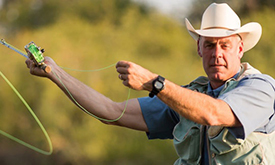
A 5th-generation Montanan who grew up near Glacier National Park, Secretary Zinke enjoys hunting and fishing (Photo: Scott Wilson / Department of Interior)
CURWOOD: What do you think is going to be Secretary Zinke's biggest challenge in office? What's the tough nut that he's facing that he's going to have to crack?
HALL: Oh, well, his department is so large, but I would say that the Endangered Species Act and bringing it back to where people stop fighting and start making it work the right way. Energy is certainly going to be a large challenge - How to do it the right way - Because America is still addicted to carbon and whether we like it or not we're not ready to flip the switch yet and go to solar and geothermal and all the other types of renewable resources. We're just not ready for that yet, from the grid standpoint. So I think energy and management of the public lands, which includes endangered species, will be his probably two largest challenges.
CURWOOD: Dale Hall is the CEO of Ducks Unlimited and a former director of the US Fish and Wildlife Service. Thanks so much for taking the time with us today.
HALL: Thank you for having me.
Related links:
- Department of the Interior press release on Orders 3346 and 3347
- Secretary Ryan Zinke’s open letter to Interior Dept. employees
- NYTimes: “He Will Soon Run a Fifth of the Nation. Meet Ryan Zinke.”
- Ducks Unlimited statement on Ryan Zinke’s confirmation as Secretary of the Interior
[MUSIC: New York Philharmonic/Leonard Bernstein/John Corigliano, “The Grand Canyon Suite III, On the Trail,” Ferde Grofe, RCA Camden Records]
CURWOOD: Coming up...the surprising and concerning cause of thousands of deaths in and around London. Stay tuned to Living on Earth.
ANNOUNCER: Support for Living on Earth comes from the Gordon and Betty Moore Foundation, and from a friend of Sailors for the Sea, working with boaters to restore ocean health.
[MUSIC: New York Philharmonic/Leonard Bernstein/John Corigliano, “The Grand Canyon Suite III, On the Trail,” Ferde Grofe, RCA Camden Records]
Smog-Shrouded London
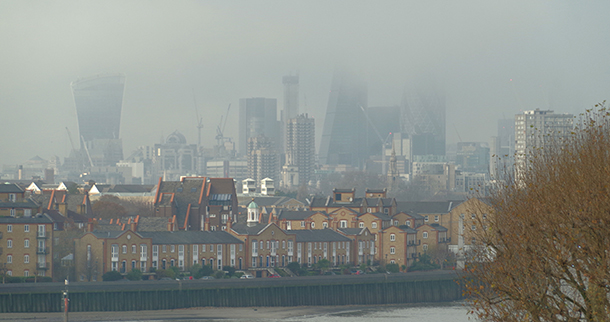
The air pollution caused by diesel vehicles today is reminiscent of The Great Smog of 1952. (Photo: Matt Buck, Flickr CC BY-SA 2.0)
CURWOOD: It’s Living on Earth, I’m Steve Curwood. A few days before Christmas in 1952, weather conditions and the burning of sulfur-laden coal combined to shroud London in a deadly ‘pea-souper.’ Researchers attribute as many as 12,000 deaths to that “Great Smog” 65 years ago, and once again London is enduring toxic air pollution linked to thousands of premature deaths. But this time the tailpipes of diesel vehicles rather coal fires are to blame, and London Lord Mayor Sadiq Khan now suggests children should be given gas masks to protect their lungs.
James Thornton is CEO and founder of ClientEarth, a public interest law group that has been putting pressure on the British Government to clean up the air. He joins us now from London. Welcome to Living on Earth.
THORNTON: Thank you. It's a pleasure.
CURWOOD: So, London has got an air quality problem. I mean, this isn't like the Great Smog in 1952, with the coal burning and suffocating the city and literally thousands of people dying, but, still, what exactly is creating such terrible air quality for London right now?
THORNTON: It is terrible. You were just saying it's not like the Great Smog, and in some ways it's not visible like the Great Smog, but is killing thousands of people. They're just not falling down the street like they were during the Great Smog. So, the problem now is diesel vehicles. That's the main source of the air pollution problems in London and throughout western Europe. Eastern Europe you start adding a lot of coal to the air pollution problem.
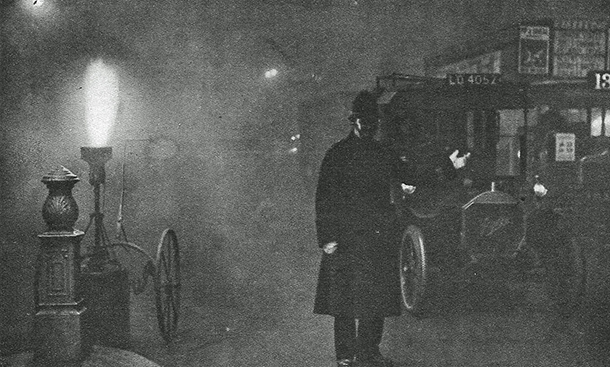
During the first half of the twentieth century, acetylene flares were used at traffic points in London like Trafalgar Square, shown above during a period of heavy smog known as a “pea souper.” (Photo: Leonard Bentley, Flickr CC BY-SA 2.0)
What we now have makes it much harder to realize there's a problem in that it's NO2, which is a poison and invisible gas, and perfectly clear. In the old days of the pea soup fog, you could see, or actually you couldn't see across the street. Now it all looks nice but is poisonous. And the government's numbers, probably conservative, are that you have around 40,000 people a year dying early of air pollution in the UK, around 9,000 in London. So, it causes heart attacks, strokes, in children, particularly in children who are heavily exposed, it can prevent the development of their lungs. So, very serious stuff.
CURWOOD: Now, the problem, you say, is diesel. Compare that to gasoline, what we have here in America.
THORNTON: Yeah, gasoline is a much better fuel from the point of view of pollution and human health. If you think about it, diesel is like the stuff at the bottom of the barrel. It's thick and nasty and polluting, and since they refine gasoline it's a bit like cognac that comes off the top. It is cleaner. When diesel burns, it gives off masses of these fine particles of dark and very, very black particles that go right into the lungs, will go into the bloodstream, and it produces many times more of this NO2 gas than gasoline does. So, what happened is we fell in love in Europe with diesel, and it turned out to be a really bad love affair.
CURWOOD: Why did Europeans like diesel so much?
THORNTON: Well, there are a couple of theories. One is that after the war, because the Europeans decided to tax diesel at a very low amount so that farmers could use it in their vehicles, people started building diesel cars to burn diesel, and people got used to it and kept using it. In more recent times there was the idea that it produced less CO2 to burn diesel than petrol and that would be good for the climate. Overall it’s clearly very bad for human health and turns out not to be very much better for climate with modern engines.
Also, unlike petrol engines, you have these real problems. I'm sure you've heard that scandal with Volkswagen emitting through its diesel engines tremendously more of these pollutants than it's supposed to do, and that's a particular problem with diesel.
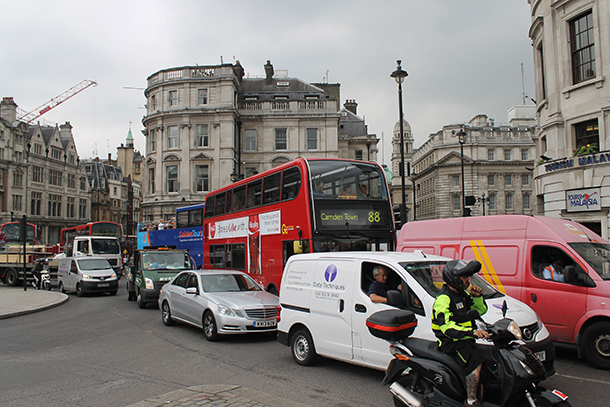
According to Eurostat’s 2016 Urban Europe Report, London has the worst traffic congestion in Europe. This is causing more air pollution and a financial cost of about $5 billion a year to Britain, says a study by Transport for London. (Photo: Connie Ma, Flickr CC BY-SA 2.0)
CURWOOD: As I understand it, the European Union has now ordered Britain to reduce car pollution to meet EU regulations or wind up in the European Court of Justice to face fines. How do things get to the point that the British government is now getting told by the EU to clean things up?
THORNTON: Well, it's been very reluctant to follow the law. We actually sued the British government in 2010 over this. In 2009, we wrote a very polite letter, as one does in Britain, and said to them, “You're violating the law. You have come into compliance by 2010. All these people are dying early of air pollution according to your own numbers. What are you going to do about it?” And they wrote back and said, “We intend to absolutely nothing. We know we have to come into compliance by 2010. We won't come into compliance till at least 2025 and maybe later.”
So, that was a surprising letter to receive and we then had to go to court, and we had to take it all the way up to the Supreme Court. In the Supreme Court, the UK government stood up and said, “You know, Client Earth is right. We're violating the law. It's our own numbers that they're using on the people who are dying early due to air pollution, but we have no intention of complying until at least 2025, and you, the Supreme Court, may not order us to do so.” The Supreme Court turned to us and said, “Well, the government has said they have no intention of complying with law. What would you like us to do? We’re only that Supreme Court.”
Good question, and a constitutional moment which was decided in 1802 in United States in a case called Marbury against Madison, when the Supreme Court asserted its authority to tell the government to comply with the law.
So, we said, “Forget that this is an environmental case. This could be a securities case or a public procurement case or a family law case, any type of case. If the government can walk into the Supreme Court and say, “We're only going comply with law when we feel like it,” then it's not a government under the rule of law. It's a government by fiat and diktat.” And the Supreme Court very nicely said, “Well, now you put it that way, [LAUGHS.] here is an injunction.” That was the first environmental injunction they ever gave against the government.
CURWOOD: So, why is the government dragging his feet about such a clear-cut public health issue? As you say, people are dying from it.

Volkswagen’s excess emissions generated between 2008 and 2015 will lead to 1,200 Europeans dying early, each losing as much as a decade of their life. (Photo: Richard G. Hawley, Flickr CC BY-ND 2.0)
THORNTON: You know, it's simply a reluctance to deal with cars, I think. I remember in California a politician, back when I worked in Los Angeles at the NRDC, Tom Hayden, saying that his political mentor told him, "Tom, you'll have a great career as long as you don't mess with people's guns or their cars," and there's something of that going on I think. They don't want to mess with people's cars.
When we were in court we showed the court documents in which the government had taken its plan to the treasury, which has to approve expenditures, and the treasury said, “Well, just delay it as long as possible because we will save some money for some years.” Now, this is one of those laws because it's a human health law that explicitly says, saving money is not an option.
CURWOOD: So, what kind of plan are you talking about here, and even if there is a plan, I mean, how quickly would it be able to reduce the air pollution to a safer level?
THORNTON: Well, it's not rocket science. So, we need to move people away from diesel. There are various ways to do that. One is to prohibit diesel vehicles from coming in when pollution is high. Another is to give tax incentives so that you tax diesel higher than petrol. Another would be to give tax reductions on cleaner vehicles. And something that has been pioneered in Los Angeles and has done a very good job there over decades is to have a scrappage scheme in which, if you're one of the poorest people in one of the dirtiest neighborhoods, you get up to $16,000 to turn in your car - Enough to buy a secondhand Prius - And they've calculated that that would actually be a net economic benefit. So, that's the kind of inspirational thinking that we need, and it would work if we did it here and we will have to do it here.
CURWOOD: So, cash for clunkers you're saying, huh?
THORNTON: Cash for clunkers is an important part of it.
CURWOOD: So, now you have the EU looking at this as well as Britain's highest court. What's about Brexit? What happens when the UK leaves the European Union? What will happen to the air quality regulations and enforcement?
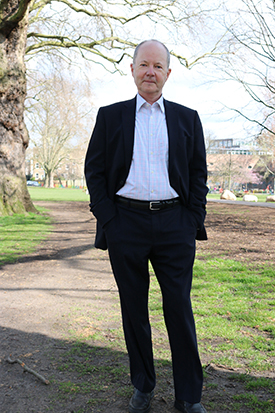
James Thornton currently resides in England, is the founding CEO of ClientEarth, and focuses on biodiversity loss, climate change, and toxic chemicals. In the United States, Mr. Thornton founded the Citizen’s Enforcement Project at NRDC in New York as well as the Los Angeles Office of NRDC. (Photo: ClientEarth)
THORNTON: Well, Brexit keeps everybody who is interested in environmental performance in the UK up at night. You know, what we're told by the prime minister is that all of the laws now that were generated by our participation with the EU will be brought over into UK law so that the day after Brexit all of those laws will still apply. And you have to do that, of course, or you would suddenly have no law on the books. If you do it right, then we'll still be able to enforce these laws.
Parliament over time would be able to change them, and the UK government, unless it changes its heart, will certainly try to weaken the air quality laws, and there's a big movement now to say, “After Brexit we need a new Clean Air Act that's stronger rather than weaker.” But after we won our first case in the Supreme Court, the UK government actually went Brussels to try and increase the pollution limits, so it could say was meeting them without doing anything. So, the level of governmental inaction and bad faith is depressing when the result is that citizens are suffering.
CURWOOD: So, what's holding them back? When you're kept up late at night, what do you think motivates these people to be so obstructionist at this point?
THORNTON: I think it's stupidity, largely. You know, it's an old form of thinking in which we, the government, get to do what we want, and you can't disturb us. It's a kind of antidemocratic thinking, and, you know, with society in transition we've seen the right-wing government get in in Poland. We've seen Brexit in the UK. We've seen the election results in the United States.
There's been a lot of talk about “the people.” For example, Mr. Trump has been talking about the “enemies of the people”, including the press. Here, when the judges decided to trigger Brexit, parliament had to have a vote. The right-wing newspapers described the judges as “enemies of the people,” and Brexit was said to be “the will of the people.” To me, if you actually wanted to do something for the people, you would clean up their air, you would clean up their water.
CURWOOD: James Thornton is the CEO of Client Earth, a public interest environmental law organization based in London. Thanks so much for speaking with us today.
THORNTON: It's a great pleasure. Thank you.
Related links:
- The Independent: “London's air pollution worse than Beijing's as smog chokes UK capital”
- NYTimes: “A Push for Diesel Leaves London Gasping Amid Record Pollution”
- An MIT-led study found Volkswagen’s excess emissions will lead to 1,200 premature deaths in Europe
- The Telegraph: The statistics about diesel are crystal clear. It’s deadly”
- BBC: “Law needed to limit Brexit's environmental impact, say MPs”
- Financial Times: “Special achievement award: James Thornton, ClientEarth law firm”
- About James Thornton
Dangerous Drifting Particles
_8633.jpg)
New research into long-range transportation of PAHs explains the levels of these pollutants recorded in remote places such as the mountains of Glacier National Park. (Photo: Tobias Klenze, Wikimedia Commons CC BY-SA 4.0)
CURWOOD: Polycyclic aromatic hydrocarbons sound like some exotic fragrance, but they’re actually toxic air pollutants produced by fuel combustion that have been linked to lung cancer and other serious health problems. Currently, these compounds are treated as a local issue in places with smog and bad air quality, but recent findings suggest that these pollutants may actually travel long distances and affect people across the globe. And according to a recently published paper, this significantly increases the overall health risk associated with polycyclic aromatic hydrocarbons, PAH for short.
Staci Simonich is a Professor of Chemistry at Oregon State University and co-author of this research, and she joins us now to discuss the findings. Welcome to Living on Earth.
SIMONICH: Thank you. I'm happy to be here.
CURWOOD: Now, you've done a great deal of research on these polycyclic aromatic hydrocarbons. Please describe to our listeners what these compounds are and what we know about them.
SIMONICH: Well, they've really been around since we had combustion. So, whenever there's been fire we've created these PAHs, and so we're still learning about these compounds. We're still learning about how they move in the environment and what their effects on people and the environment are.
CURWOOD: Now, you recently published in the proceedings of the National Academy of Sciences how these compounds move, and how people are exposed to them in rather surprising ways, I think. So, please describe this research and what you did find.
SIMONICH: Well, my own group here at Oregon State University, we've been studying air pollution and PAHs and how they move from source regions including Asia and China, how people are exposed there, and we've been studying how they transport across the Pacific Ocean to the US west coast. So, for about 16 years we've been studying this transport, how much in the US is coming from other countries, how much is from our own sources, and part of the discrepancy in this was that the measurements we were making at high elevation remote areas were higher than the models predicted. And so this piece of work really puts together experiments in the laboratory, modeling, and field measurements to come up with a new explanation for why these PAH concentrations are higher.
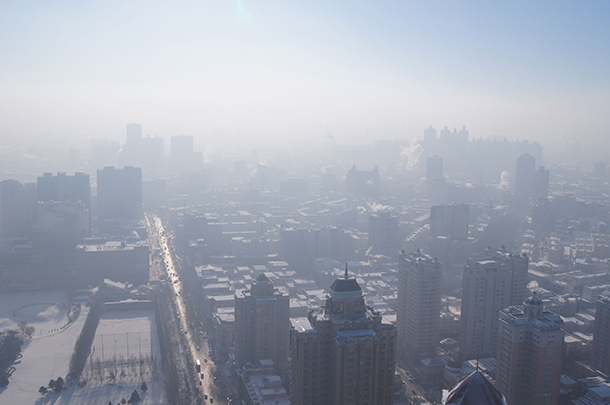
Pollution from coal and other fuel combustion not only exposes people to PAHs locally, but can transport them thousands of miles to other countries (Photo: Fredrik Rubensson, Wikimedia Commons CC BY-SA 2.0)
CURWOOD: So, what did you suspect as the reason that these chemicals were being found in places that really didn't seem like that was a place you would find them?
SIMONICH: Well, there was some unexplained reason in terms of the modeling side, and what we found with our researchers at Pacific Northwest National Lab is that on particles, these PAHs are actually shielded or protected from reactions in the atmosphere. And so we're talking about particles that are on the size less of than one micrometer in diameter, so about five or six of these particles fitting across the width of a human hair. Because they're such fine particles, they don't settle out near source regions, so near, let's say, major urban areas, they get pulled into the atmosphere and can undergo transport in high elevation winds where they're intercepted, and they ultimately come out of the atmosphere due to rain and snow.
CURWOOD: Part of your paper discusses what you call a ‘shielding’ effect. What do you mean by that?
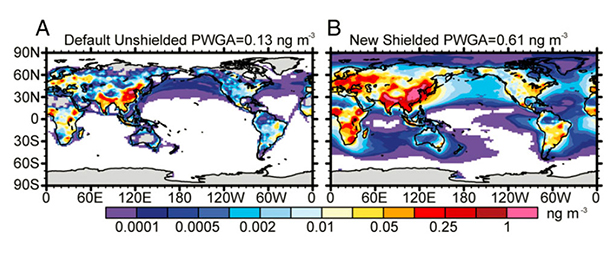
Figure from Shrivastava et al.’s 2016 paper in PNAS showing how inclusion of long-range transport into PAH models dramatically increases predicted concentrations worldwide (Photo: Shrivastava, Manish, et al. "Global long-range transport and lung cancer risk from polycyclic aromatic hydrocarbons shielded by coatings of organic aerosol." Proceedings of the National Academy of Sciences 114.6 (2017): 1246-1251.)
SIMONICH: So, we mean that, after a PAH is emitted on a particle from the tailpipe, that it can immediately be surrounded by atmospheric reactions that create a layer over these PAHs and protect them from reaction with oxidants in the atmosphere. So, the end result is, they travel long distances and don't degrade in the atmosphere.
CURWOOD: Where was the most surprising place that you found these cancer-causing chemicals when you did this research?
SIMONICH: So, we find them in any place we look, so, of course, whether it's a major urban area or on islands and also mountaintops at 2,700 meters. Actually some of the places that surprised me the most and over the years, we found them in Glacier National Park at relatively high concentrations, and we were able to link them to an aluminum smelter outside of the park.
CURWOOD: So, how are people exposed to polycyclic aromatic hydrocarbons that have been transported to long distances?
SIMONICH: In daily life, the main sources are diet and smoking and indoor air exposure, but through the long-range transport it's just part of our outdoor air, and outdoor air becomes indoor air.
CURWOOD: So, we know that polycyclic aromatic hydrocarbons are considered carcinogenic. I know there's a lot of focus on lung cancer, but what other cancers might they be connected with?
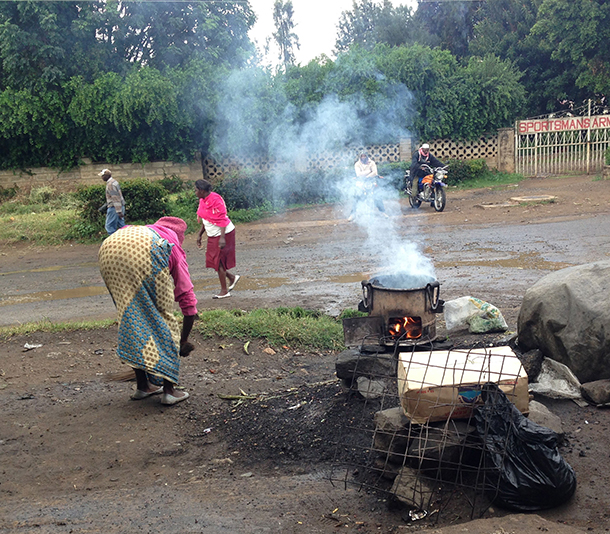
Open cooking fires, such as this one in Nanyuki, Kenya, have been a source of human exposure to PAHs for thousands of years. (Photo: Alexander Metzger)
SIMONICH: You're right. This study focused on lung cancer, and that's because we have most of the data available around lung cancer and atmospheric particulate matter, but we're finding that PAHs have other effects on humans and other organisms, can include cardiovascular effects, and even developmental effects when a fetus is developing.
CURWOOD: So, there's a chart that comes with your study that shows that the level of risk is elevated on both coasts of the US and much of sub-Saharan Africa. Why do you think that might be?
SIMONICH: Well, let's take the US as an example. Now we've understood that the concentrations are actually higher on the US west coast than we had previously modeled. So that's coming from emissions in Asia, primarily China, that are transported long distances, and on the east coast of the US we have our own sources of PAHs, and our modeling now suggests that those emissions within the US are transporting to the next state and other states downwind with the winds blowing primarily from west to east.
CURWOOD: Now, there's some articles about your research that have mentioned that new models which consider this long-range transportation of polycyclic aromatic hydrocarbons have predicted a four times greater cancer risk than previously. In fact, the risks now exceed World Health Organization standards. What implications does this have on how these emissions should be regulated in the future, do you think?
SIMONICH: Well, I think we have to remember that the major areas of risk are major megacities in parts of China and parts of India where the air quality now is certainly among the poorest in the world. But I always like to say, “What goes around comes around,” so it drives home that idea that we're a connected atmosphere, right? And that what happens in one part of the world impacts other parts of the world. We're all united in one atmosphere.
CURWOOD: So, tell me, what are some of the ways that exposure to polycyclic aromatic hydrocarbons might be reduced, considering these new findings?
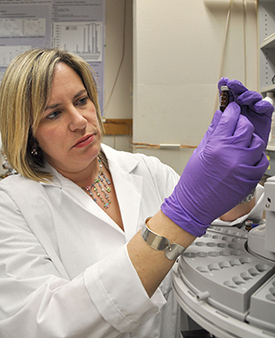
Staci Simonich examines an air pollution sample in her lab at Oregon State University. (Photo: Tiffany Woods / Oregon State University, Flickr CC BY-SA 2.0)
SIMONICH: Well, I think you in our own personal daily lives, not smoking is a big one. Thinking about our diets, and personally I love barbecue and I love grilling, so I do it in moderation, and I eat it with a balanced diet. It's not something I've given up.
So, we can think about our own personal exposures, but then on a national and international scale we can think about technologies that help reduce emission of PAHs from coal combustion, from biomass combustion. So, in China the main sources of PAHS to the atmosphere are coal combustion and biomass combustion followed, third, by automobiles. So, it's really controlling those sources of particulate matter that have PAHs on them that can play a large role in reducing global atmospheric concentrations of PAHs.
CURWOOD: Staci Simonich is a Professor in the Department of Chemistry at Oregon State University. Thank you so much for taking time with us today.
SIMONICH: Thank you.
Related links:
- The full research article from Manish Shrivastava and Staci Simonich’s research team
- Oregon State University press release on long-distance transport of PAHs
- Pacific Northwest National Laboratory press release on long-distance transport of PAHs
[MUSIC: Project, “Shir” on Instrumental, Harmonyville Records]
CURWOOD: Coming up...the gender gap in bicycle transportation. The reasons why are just ahead here on Living on Earth. Stay tuned.
ANNOUNCER: Funding for Living on Earth comes from you our listeners, and United Technologies - combining passion for science with engineering to create solutions designed for sustainability in the aerospace, food refrigeration and building industries. UTC companies such as Otis, Carrier, Pratt & Whitney and UTC Aerospace Systems are helping to move the world forward. This is PRI, Public Radio International.
[CUTAWAY MUSIC: Jim Henry, “When Maggie Comes To Visit” on Jacksonville, Signature Sounds.]
Beyond The Headlines
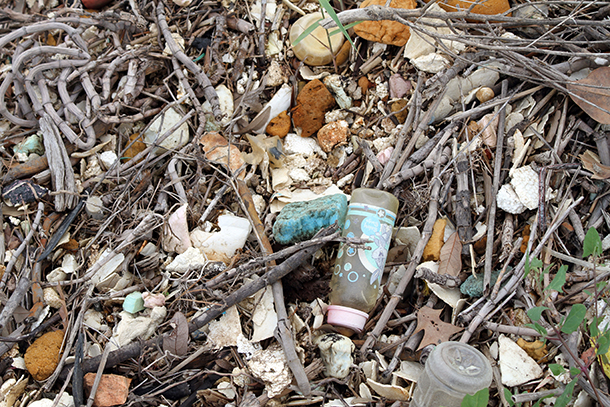
Litter collected on the 2012 Clean the Bay Day in Portsmouth, VA. The Trump Administration’s expected EPA budget cuts would slash conservation funding for the Chesapeake Bay by 93%. (Photo: U.S. Army Corps of Engineers, Flickr CC BY 2.0)
CURWOOD: It’s Living on Earth. I’m Steve Curwood.
Let’s see what’s up beyond the headlines now. Peter Dykstra of DailyClimate.org and Environmental Health News, that’s EHN.org joins us from Conyers, Georgia. Peter, hey, how are you doing today?
DYKSTRA: I’m doing OK, Steve.
Let’s start with the Trump administration’s leaked proposals to slash major parts of EPA’s budget, with some of the deepest cuts seemingly fixated on crushing some iconic American environmental successes, regardless of cost or controversy.
The Great Lakes used to be a poster child for American water pollution – The near-death and then the recovery of Lake Erie, invasive species like lampreys and zebra mussels, and, of course, the multiple times back in the day when Cleveland’s Cuyahoga River caught fire and burned.
CURWOOD: Yeah, the problems there are stuff of legend, but the recovery has been strong, as you point out. You’re thinking that’s about to change?
DYKSTRA: Well, draft budget cuts to EPA’s Great Lakes Restoration Initiative would kill all but three percent of its funding. In the words of one observer, “If we lose EPA, we lose Lake Erie. Again.”
CURWOOD: And what about other, similar programs?
DYKSTRA: The project to restore San Francisco Bay’s wetlands, efforts to reverse decades of nutrient pollution in Chesapeake Bay, and in that one the funding is cut by 93 percent. There’s potential elimination of EPA’s environmental justice efforts, and this one, which to me is just crazy. EPA’s successful, non-controversial EnergyStar program , the one that saves consumers billions of dollars by steering them to the most energy-efficient, big appliances like dishwashers and refrigerators. According to some reports, EnergyStar’s plug could be pulled. The source of these reports is not EPA, but the federal Office of Management and Budget, which would oversee the apparently big changes at the environmental agency.
CURWOOD: Well, uh, Peter I hope you’ve brought us some more upbeat news.
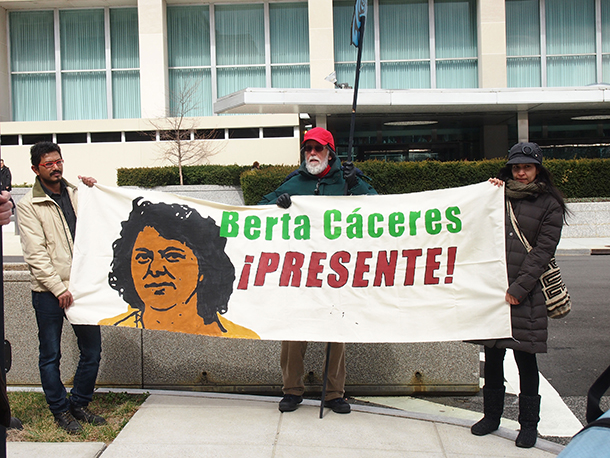
Protesters demonstrated outside the State Department following the murder of outspoken Honduran environmental justice activist Berta Cáceres in 2016. Two army officials arrested for her murder were trained at the School for the Americas in Fort Benning, GA. (Photo: Slowking4, Wikimedia Commons CC BY-NC 2.0)
DYKSTRA: Uh-uh, Steve, not today. A report by journalist Nina Lakhani in The Guardian has found second-hand American fingerprints on the murder of Honduran environmental activist, Berta Cáceres. Berta was murdered in her home just a year ago this month, after reportedly enduring 33 death threats for her opposition to a hydro dam. In 2015, she won the Goldman Environmental Prize, which is sort of the Nobel for environmental activists.
CURWOOD: Yeah, that’s right. We reported on her winning the Goldman. As I recall, several Honduran soldiers were arrested for her murder. Where does it all stand now, and what’s the U.S. tie-in?
DYKSTRA: Well, two of the eight men arrested were Honduran army officers who received military training in the U.S., Major Mariano Díaz was Chief of Honduran Army Intelligence -- He was discharged right after his arrest -- and Lt. Douglas Giovanny Bustillo. They both received training at the School of the Americas in Fort Benning, Georgia. The training there ostensibly focuses on stopping drug trafficking and terrorism. There’s one other Army officer and five civilians also awaiting trial for the murder of Berta Cáceres in a nation that the watchdog group Global Witness calls, “the most dangerous place on Earth for environmental activists.”
CURWOOD: OK, Peter, let’s move on to our history item for this week, have you at least brought us something more cheerful there?
DYKSTRA: Well, yeah, as a matter of fact I have. The fiftieth anniversary of what’s turned out to be one of America’s biggest wildlife protection successes.
In March, 1967 the American alligator was declared endangered under a precursor law to the U.S. Endangered Species Act, which didn’t exist until six years later. Habitat loss and an unregulated trade for alligator meat and skins had nearly wiped out the somewhat less-than-lovable critters. Commercial hunting had already been banned in 1962, and the 1967 ruling protected alligators’ habitat. Over the next quarter century, ‘gators enjoyed a spectacular comeback.
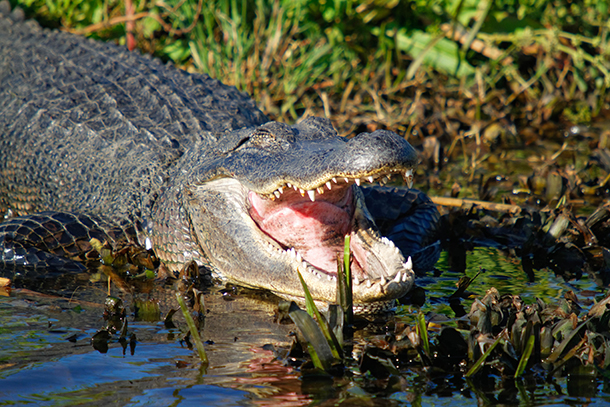
An American Alligator cracks a smile in Brazoria, Texas. Declared endangered in 1962, alligators made a huge comeback after Congress passed legislation protecting wetland habitats. (Photo: Ronald Woan, Flickr CC BY-NC 2.0)
CURWOOD: Yeah, it’s one thing to find public support for a big, cute animal like a manatee, but I gather ‘gators had to battle a PR problem in addition to overhunting. Maybe it's the teeth.
DYKSTRA: Well, battle it they did, and they won the survival battle. And thirty years ago, in 1987, they were removed from the endangered list. Today alligators range from Texas to the Carolinas, not to mention the indestructible urban myth that they inhabit the sewers of New York City.
CURWOOD: Of course, they’re down there, Peter. Come on! Peter Dykstra is with EHN.org and DailyClimate.org. Thanks. I’ll talk to you again real soon.
DYKSTRA: OK, Steve, thanks a lot. Talk to you soon.
CURWOOD: And there’s more at our website LOE.org.
Related links:
- Toledo Blade: “Trump budget virtually kills Great Lakes initiative”
- SF Gate: “Will SF Bay wetlands restoration be a casualty of EPA cuts?”
- The Philadelphia Inquirer: “Report: Plan to slash EPA’s Chesapeake Bay cleanup plan funds 93%”
- Slate: “Trump’s EPA Plans Are ‘Just Racist.’”
- EE News: “White House plans to ‘close out’ Energy Star, other programs”
- The Guardian: “Berta Cáceres’ court papers show murder suspects’ links to US-trained elite troops”
- U.S. Fish & Wildlife Service: the American Alligator
[MUSIC: Bill Haley and His Comets, “See You Later, Alligator” on Rock Around the Clock, Decca Records]
Women and Bicycling
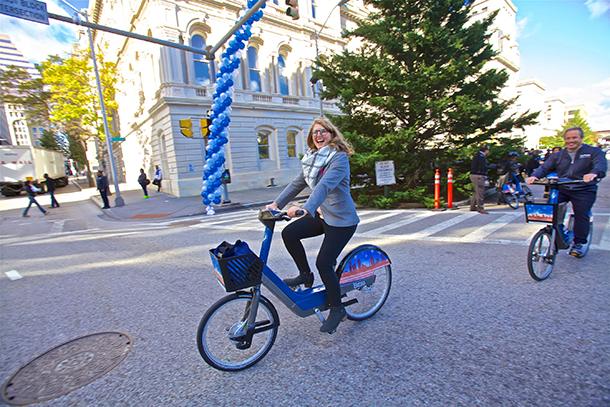
Liz Cornish, the director of Bikemore, heads a number of bike advocacy initiatives in Baltimore, Maryland. (Photo: Mark Dennis)
CURWOOD: In many parts of Europe, bicycles seem to be everywhere, especially in countries like Denmark and the Netherlands, where bikeways are filled with men and women, young and old, and commuters dressed for work or school. But in the US there are few bike paths and relatively few women are out there on two wheels. Bike advocates say part of a proposed $1 trillion spending on infrastructure could be devoted to bicycle safety, which could help narrow the gender gap in pedal power. From Boston, Living on Earth’s Savannah Christiansen has our story.
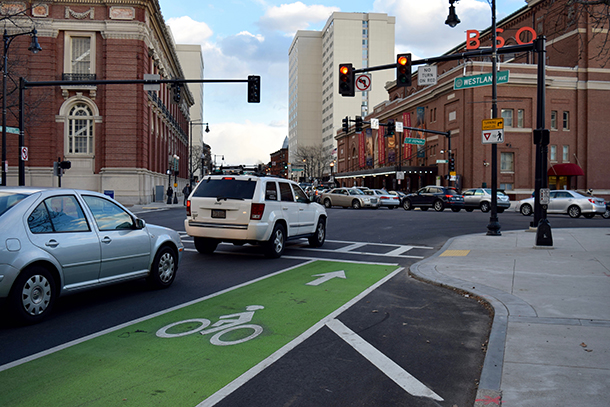
A bike lane painted bright green on Massachusetts Avenue in Boston, MA. (Photo: Savannah Christiansen)
CHRISTIANSEN: Less than a quarter of people who commute by bicycle nationally are women. And the many factors that make streets seem unfriendly to bike riders hit women especially hard.
MULLIGAN: People are turning, doors are opening and I am nervous a lot about that. I’m impressed by people who bike to work and, like, it’s a good routine to be in, but I don’t know that I could see myself…I feel like it’s stressful and I end up sweating a lot [LAUGHS]. I couldn’t be going to work after.
CHRISTIANSEN: That’s Tufts University student Danielle Mulligan. The need to look presentable at work can rule out commuting by bicycle, especially for women. Student-teacher Lois Moon points to another problem.
MOON: A big one is cars stopping all over the place. On the side of the road they often stop in the bike lane. I will say though, sometimes if a bus has stopped to pick up somebody I will, like, go around the bus, though that can also be pretty dangerous. I generally stick to the side of the road, the bike paths.
CHRISTIANSEN: In many parts of the country, there’s also ice and snow to deal with, as well as potholes and uneven pavements. And in addition to those hazards, there’s a problem with the image of bicycling.
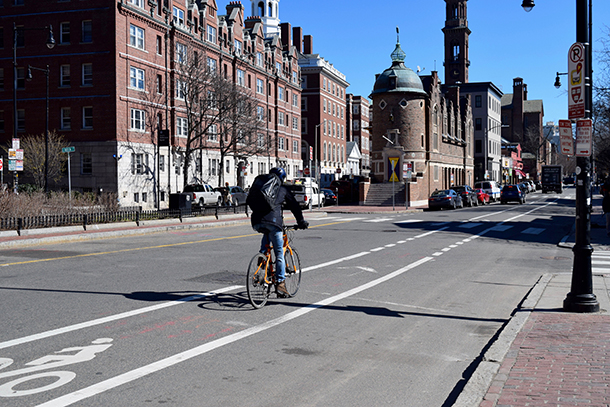
A bicyclist pedals in a bike lane in Cambridge, MA. (Photo: Savannah Christiansen)
BALMER: Over the past 30-plus years, bicycling has been from the industry’s point of view, they’ve been selling the sport of cycling.
CHRISTIANSEN: That’s Melissa Balmer. She’s the director of a California-based group called Pedal Love. She says statistics on transportation tend to reflect outdated ideas on bicycle culture.
BALMER: If you say “cycling” to majority of people in the United States, especially women, that means MAMILs: Middle-Aged Men in Lycra [LAUGHS]. That’s not what most people want to see themselves riding.

Lois Moon is a student-teacher in Brighton, MA and commutes to work and school entirely by bicycle. (Photo: Lois Moon)
CHRISTIANSEN: A major source of travel data is the Department of Transportation’s National Household Travel Survey, which hasn’t been updated since 2009. Bicycle travel is limited, compared to other possible ways of getting around, and though there’s little information on how many people travel regularly by bike, Melissa says the focus is on commuting.
BALMER: When transportation funding was from the federal level, they had to prove that they were replacing car trips by bike trips. The problem is that, over the past decade, our way of moving about and doing things has really changed. And so, right now, the majority of car trips are actually short trips rather than commuting to work, but we’re still judging whether bicycling is valuable or not by replacing commuting to work trips.

Danielle Mulligan is a student at Tufts University and usually bicycles all over the Boston Metropolitan area. (Photo: Danielle Mulligan)
CHRISTIANSEN: And Barbara Clabots, who’s an independent environmental consultant, says that focus on commuting doesn’t capture the many ways women use their bikes.
CLABOTS: We have national data on biking to work. But if you ask women around the world what they are doing on a day to day basis, they won’t describe going to pick up groceries or moving kids around the city as “work.” So you’re really missing how women move around a city.
CHRISTIANSEN: For a start, Barbara says that women tend to feel safer using bike paths separated from the road, while men are less concerned about heading off into traffic on two wheels. Liz Cornish, the director of a livable streets organization called Bikemore, says womens’ caution may reflect how we raise our kids.
CORNISH: Think about growing up and watching kids play on a playground. You’re going to see that boys are naturally socialized to take more risk, and women and girls are naturally socialized to be careful. Then we graduate to adulthood, and now all of a sudden people are asking us to ride bikes in traffic. This does not appeal to how many women are socialized to not take risks. And so, whether or not that risk is perceived or real, it’s a barrier.
CHRISTIANSEN: At her non-profit, Pedal-Love, Melissa Balmer is collecting stories to broaden the image of bicycling with diverse tales about women who travel on two wheels. She hopes to shift the sport-driven image of bicycling and promote it as a healthy and sustainable lifestyle choice.

Melissa Balmer is the founder of the national storytelling project called Pedal Love, working to promote positive stories about women and bicycling. (Photo: Lisa Beth Anderson)
BALMER: So, when we talk at Pedal Love about storytelling, we want to talk about compassion, connectivity, and creativity that the storytelling brings. But it’s also getting women to see stories of themselves in the media about bicycling. Whether they’re 20-something, whether they’re 30-something, 40-something, 50-something, however old she is, she can get out there and ride her bike.
CHRISTIANSEN: Platforms such as the National Bike Summit or the Pedal Love website, highlight ways in which women ride bicycles to visit family, reduce commute time or travel across a city, which data often fail to capture. And Barbara Clabots says researching the differences in ways people use transportation also provides insight into other issues.
CLABOTS: When you start looking at gender data you often also end up looking at race and income data, and it reveals how we don’t know what we don’t know about how people are using public transit.
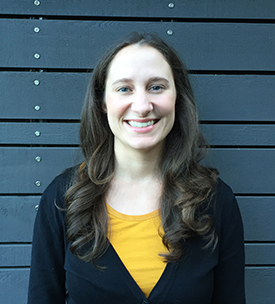
Barbara Clabots is an independent environmental consultant based in Seattle. (Photo: Barbara Clabots)
CHRISTIANSEN: Some groups, such as the League of American Bicyclists, do publish regular reports on national equity issues in bicycling. For example, in a foundational report from 2013, the League revealed that bicycle-related fatality rates for African-American and Latino riders were up to 30% higher than for white riders. And Centers for Disease Control data show that men are nearly 20% more likely to suffer fatal bicycle injuries than women. Liz Cornish of BikeMore says it’s vital to incorporate social data like these into policy to encourage wider ridership as a tool for social mobility.
CORNISH: We know that reducing commute time is the number one way that you can help families emerge from poverty. So, we can either invest in improving our transportation system, or we can make sure that every neighborhood within walking and biking distance has everything they need -- jobs, groceries, schools, healthcare.
CHRISTIANSEN: Liveable neighborhoods with bikeable streets is a dream for many young people who don’t want to own cars. But that kind of community has broad appeal, and a particular focus on bike safety could encourage more women to get out on two wheels. For Living on Earth, I’m Savannah Christiansen in Boston.
Related links:
- Barbara Clabots, Yes! Magazine: “Even in the most bicycle-friendly states, women are left behind”
- Liz Cornish: “Bike Shops for Everyone”
- Melissa Balmer, Pedal Love Cultural and Lifestyle Council homepage
- Fastcoexist: “Women and men use cities very differently”
- The Atlantic: “Wheels of change: how the bicycle empowers women”
- League of American Bicyclists: “The New Majority: Pedaling Towards Equality”
- National Highway Traffic Safety Administration: “Traffic Safety Facts -- 2013 data”
[MUSIC: Le Vent du Nord, “La Fille et les Dragons” on Dans les airs, traditional Quebecois/arr.Le Vent du Nord, Borealis Records]
Why I Wear Jordans in the Great Outdoors

CJ Goulding has only ever owned one pair of Air Jordans – a status symbol to some African-Americans -- but he’s not too concerned with keeping them pristine. (Photo: Cherish, Flickr CC BY-ND 2.0)
CURWOOD: When we think of writing about nature and the natural landscape of North America, we think of such icons as Henry David Thoreau and John Muir. They brought the natural world into focus in the 19th and 20th centuries, describing its intricacies and the glories of wilderness. But much of the landscape and wilderness unchanged by humans has disappeared. In its place, if you believe Bill McKibben we have “The End of Nature."
For the millennial generation that understanding has overshadowed their coming of age. But that doesn’t mean they don’t have their own unique and creative way of relating to today’s mediated landscape, and in an anthology of essays introduced by Mr. McKibben they have their say. The book is called “Coming of Age at the End of Nature”, and today we have another of those essays.
GOULDING: My name is CJ Goulding and I work as a lead organizer with the Natural Leaders Network, training other young leaders to connect their communities to the outdoors. And this is my essay on “Why I Wear Jordans in the Great Outdoors."
I am an African American natural leader. That phrase is not an oxymoron, but it's also not something that you normally see in the environmental world.
In the few years that I’ve been involved in environmental education and connecting people with outdoor spaces, there have been numerous occasions where I am the only person of color in the program or the only African American leader. Growing up, there was no one from my neighborhood traveling, hiking, canoeing, or spending time outdoors in these ways unless it was part of a regimented program.
But do not misunderstand the meaning behind that statement. Please do not miss my point.
I write, neither to complain that the outdoor world is an elitist one, nor to lament the disconnect between the world I grew up in and the natural world where I now lay roots. I write to celebrate the amazing opportunity available for me (and others like myself) to be a bridge between the two worlds.
On my feet, as I write, are Jordan Bred 11s, the only pair of Michael Jordan’s brand of sneakers I have ever owned in my life. His sneakers are a status symbol in the neighborhood I grew up in, a memento of importance and significance. Unfortunately, for some people they hold higher value than food, books, rent, and, in some extreme cases, even the life and well-being of another individual.
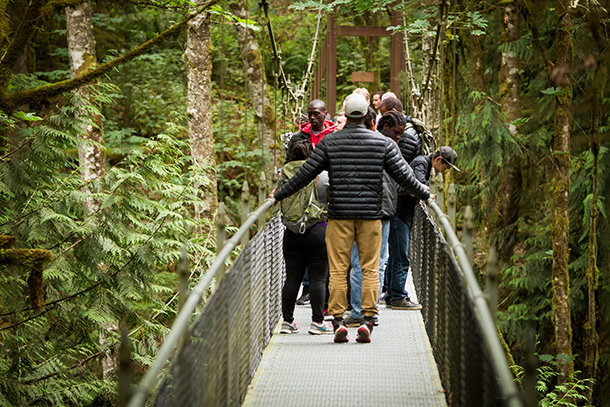
CJ Goulding leads participants from Los Angeles and Alaska in the Fresh Tracks: Leadership Program. Fresh Tracks is a cultural exchange program that builds participant skill/knowledge in cultural competence, civic engagement, and hometown stewardship. (Photo: Tony Teske)
So it makes sense that while facilitating an outdoor youth summit last June at Harpers Ferry National Park in Virginia, an African-American teenage boy stopped me to ask why I was wearing these Bred 11s outdoors. I laughed because that same question and all the underlying ones that accompanied it had been asked of me multiple times that week, and my introspective journey in figuring out that answer led me to write this story.
[MUSIC: A Tribe Called Quest, “Can I Kick It?” on People’s Instinctive Travels and the Paths Of Rhythm, Jive Records]
GOULDING: My Jordans are a symbol of the culture I grew up in, the African American culture. Everything that they are associated with. So basketball, my love of basketball, friends, family, being back home. They’re also a symbol of me being different when I come into environmental settings. And so they are a reminder that even as I come into this new setting, this new circle, that I shouldn't leave who I am at the door, and I should carry it with me.
In the years that I’ve been working in outdoor education or environmental education, the majority of my fellow educators are not people of color. And especially for me growing up, African American environmental educator, that wasn’t a job that I knew about or thought that would be possibility for me to have in the future, and so for some people from those perspectives it might be an oxymoron, but in reality it is something that is out there and that I’m living.
[MUSIC: A Tribe Called Quest, “Can I Kick It?” on People’s Instinctive Travels and the Paths Of Rhythm, Jive Records]
GOULDING: just finished a Masters program in Urban Environmental Education, and, as part of our program, we explored the nature of the city and nature in the city, so finding ways to connect to the natural things that exist even inside the concrete structures and systems that we’ve set up.
[MUSIC: A Tribe Called Quest, “Can I Kick It?” on People’s Instinctive Travels and the Paths Of Rhythm, Jive Records]
In my time working as an environmental educator, I’ve learned that representation means a lot, not only for myself as an African American leader, but for the youth that I work with. And there’s also lessons that I believe can be learned by the environmental field as a whole. And this is how I wrote about it in my essay.

CJ Goulding is lead organizer at the Natural Leaders Network based in Seattle, Washington. (Photo: Tony Teske)
I no longer saw the singularity of my skin tone among my peers as a problem, but instead as a megaphone to give weight to the message that as people of color, people from different ethnic backgrounds, the outdoor world is ours to explore as well. And through us, for those who had grown up connected to and educated in the outdoors, we offer the chance to connect to new cultures, to see flora and fauna through the eyes of city kids and people from different backgrounds.’
[MUSIC: A Tribe Called Quest, “Can I Kick It?” on People’s Instinctive Travels and the Paths Of Rhythm, Jive Records]
CURWOOD: That’s CJ Goulding with his essay “Why I wear Jordans in the Great Outdoors”, from the book, Coming of Age at the end of Nature”.
[MUSIC: A Tribe Called Quest, “Can I Kick It?” on People’s Instinctive Travels and the Paths Of Rhythm, Jive Records]
Related links:
- Listen to the first essay in the series: “Urban Foraging at the End of Nature”
- Listen to the second essay in the series: “High Tech Rain”
- Listen to the third essay in the series: “Fossil Fuel Freedom Fighters”
- Read the book, “Coming of Age at the End of Nature”
- Read more from CJ Goulding at the Children and Nature Network
- CJ Goulding’s Twitter account
Next time on Living on Earth, how presenting facts and science in certain ways can stop people from being taken in by false arguments.
LEISEROWITZ: What we seem to have found here is that it is possible to essentially innoculate the mind against disinformation, which certainly has major implications for the larger issue around fake news.
CURWOOD: It can even make doubters accept climate science. That’s next time, on Living on Earth.
[MUSIC: Reuben Gonzalez, “Date Una Vueltecita” on Momentos, Cuban Essentials/ Escondida Records]
CURWOOD: Living on Earth is produced by the World Media Foundation. Our crew includes Naomi Arenberg, Bobby Bascomb, Savannah Christiansen, Jenni Doering, Noble Ingram, Jaime Kaiser, Don Lyman, Alex Metzger, Kit Norton, Helen Palmer, Adelaide Chen, and Jolanda Omari. Tom Tiger engineered our show, with help from Jeff Wade and Jake Rego.
Alison Lirish Dean composed our themes. You can hear us anytime at LOE.org -- and like us, please, on our Facebook page , PRI’s Living on Earth. And we tweet from @LivingOnEarth. I'm Steve Curwood. Thanks for listening.
ANNOUNCER: Funding for Living on Earth comes you, our listeners, and from the University of Massachusetts, Boston, in association with its School for the Environment, developing the next generation of environmental leaders. And from the Grantham Foundation for the protection of the environment, supporting strategic communications and collaboration in solving the world’s most pressing environmental problems. Support also comes from the Energy Foundation, serving the public interest by helping to build a strong, clean, energy economy, from Carl and Judy Ferenbach of Boston, Massachusetts and from SolarCity, America’s solar power provider. SolarCity is dedicated to revolutionizing the way energy is delivered by giving customers a renewable alternative to fossil fuels. Information at 888-997-1703. That’s 888-997-1703.
ANNOUNCER-2: PRI. Public Radio International.
Living on Earth wants to hear from you!
Living on Earth
62 Calef Highway, Suite 212
Lee, NH 03861
Telephone: 617-287-4121
E-mail: comments@loe.org
Newsletter [Click here]
Donate to Living on Earth!
Living on Earth is an independent media program and relies entirely on contributions from listeners and institutions supporting public service. Please donate now to preserve an independent environmental voice.
NewsletterLiving on Earth offers a weekly delivery of the show's rundown to your mailbox. Sign up for our newsletter today!
 Sailors For The Sea: Be the change you want to sea.
Sailors For The Sea: Be the change you want to sea.
 The Grantham Foundation for the Protection of the Environment: Committed to protecting and improving the health of the global environment.
The Grantham Foundation for the Protection of the Environment: Committed to protecting and improving the health of the global environment.
 Contribute to Living on Earth and receive, as our gift to you, an archival print of one of Mark Seth Lender's extraordinary wildlife photographs. Follow the link to see Mark's current collection of photographs.
Contribute to Living on Earth and receive, as our gift to you, an archival print of one of Mark Seth Lender's extraordinary wildlife photographs. Follow the link to see Mark's current collection of photographs.
 Buy a signed copy of Mark Seth Lender's book Smeagull the Seagull & support Living on Earth
Buy a signed copy of Mark Seth Lender's book Smeagull the Seagull & support Living on Earth

